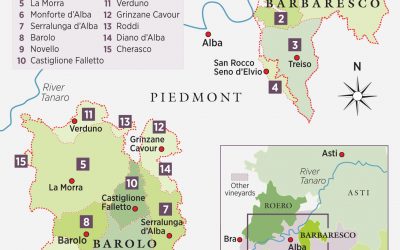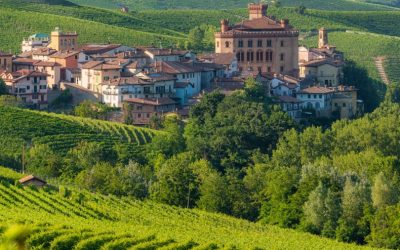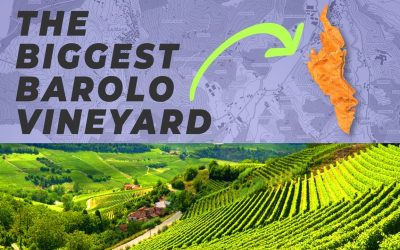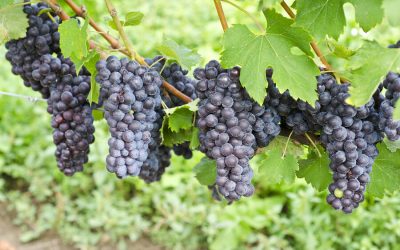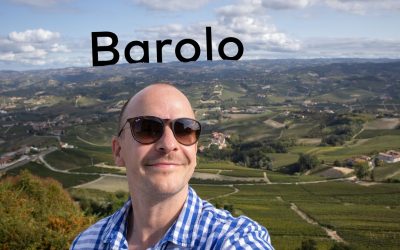Guide to Barolo 2016 Vintage: 48 FAQ about the King
There’s something inherently special about Italian wine, but when it comes to Barolo, the so-called ‘King of Wines and Wine of Kings,’ the charm doubles. The year 2016 was a blessing to the Italian wine landscape, particularly for Barolo, renowned for its superb structure and balance, with critics celebrating it as one of the best vintages of the decade. Delve into the enchanting world of 2016 Barolo, explore the ten best wines for an immersive tasting experience, and join us on a captivating journey through the sun-dappled vineyards with Alba City Tours.
Why is Barolo so expensive?
Barolo is often called the “King of Wines,” and with that title comes a price to match. There are several reasons for Barolo’s higher price tag. Firstly, the Nebbiolo grape, from which Barolo is made, is particularly sensitive to environmental conditions, making it difficult to grow. Secondly, the wine laws of Barolo dictate that the wine must be aged for a minimum of 38 months before release, with at least 18 months in oak barrels, leading to higher production costs. Finally, the high demand and limited supply of these meticulously crafted wines further drives up their price.
🍷 2016 has been hailed as an exceptional vintage for Barolo, with many wine experts and critics referring to it as a “classic” year. This vintage was characterized by optimal weather conditions, leading to an excellent balance of sugar, acid, and phenolic compounds in the Nebbiolo grapes. The resultant wines have intense flavors, firm structure, and high acidity, which are hallmarks of great Barolo. These wines are predicted to age very well, potentially over many decades. Therefore, while you can drink a 2016 Barolo now, it may be worth it to allow the wine to mature further and reveal its full complexity over time.
🍷 In terms of overall wine production, the year 2016 was indeed a stellar year for Italy. In addition to the success in Barolo, other regions like Tuscany and Veneto also reported excellent vintages. The weather conditions that year were favorable for many Italian wine regions, contributing to the high quality of the grapes. It’s generally accepted that a good vintage year for one type of wine, such as Barolo, will often be good for other wines in the region as well, and 2016 was no exception to this. Therefore, whether you’re a fan of Barolo or any other Italian wine, the 2016 vintage is one worth seeking out.
Barolo 2016 Vintage
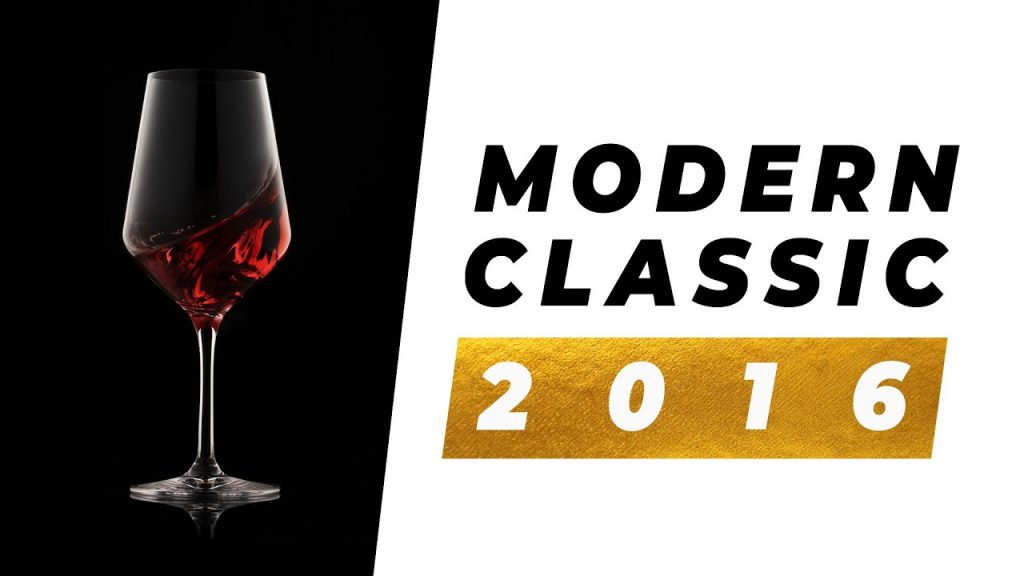
The world of wine is vast and multi-faceted, inviting enthusiasts to explore its variety and complexity. The Barolo wines, hailing from the Piedmont region in Italy, are one such example of this richness. Produced from the Nebbiolo grape, Barolo wines are known for their deep flavors and potential for long-term aging. The 2016 vintage, in particular, is hailed as a standout year, producing Barolo wines of exquisite quality and balance.
If you’ve ever been fascinated by the nuances of wine, taking part in a wine tasting experience of 2016 Barolo wines is a journey worth embarking on. Let’s explore the compelling reasons to immerse yourself in this exquisite experience, inspired by the insights shared by experts at Gigi Rosso Winery.
| Key Highlights of the 2016 Barolo Wine Tasting Experience | Description |
|---|---|
| Exceptional Vintage Year | The 2016 vintage is widely acclaimed for its exceptional quality. Favorable weather conditions led to a balanced crop, with wines demonstrating deep, concentrated flavors, firm tannins, and vibrant acidity. |
| Notable Wineries | The Piedmont region boasts illustrious wineries such as Piedmont Passion and Nebbiolo Nirvana. Their 2016 Barolos like Barolo Reserva and Barolo Monforte showcase the aging potential of Nebbiolo and the region’s diverse terroir. |
| Understanding the Value | Barolo wines are seen as an investment. A tasting experience allows understanding of the factors contributing to their value, such as cost of production, meticulous winemaking, aging potential, and the prestige of the Barolo name. |
| Sensory Exploration | A wine tasting is a sensory journey, delving into the world of wine aromas and flavors. The 2016 Barolos present a symphony of aromatic notes, from ripe red fruits, rose petals, and spices, to deeper notes of leather, tobacco, and even tar as they age. |
| Wine and Food Harmony | Barolo wines and Italian cuisine share a deep connection. A wine tasting tour often includes sampling local Piedmontese cuisine, allowing exploration of the harmony between Barolo wines and traditional dishes. |
| The Chance to Learn | A wine tasting tour is a learning experience. Guided by knowledgeable sommeliers or winemakers, you’ll gain insights into the winemaking process, the intricacies of terroir, and the art of wine tasting. |
In conclusion, a wine tasting tour, such as those offered by Alba City Tours, is a fantastic way to engage with the world of Barolo. Whether it’s a one-day journey or a two-day immersive experience, this journey promises to deepen your appreciation for these splendid wines and the passion behind them. So why wait? Step into the world of Barolo and embark on your wine tasting adventure today.
Best Barolo 2016 for Wine Tasting Experience during a tour
| Rating | Wine | Description |
|---|---|---|
| 100 | 2016 Brovia ‘Brea Vigna Ca’ Mia’, Barolo DOCG | A drop-dead gorgeous wine with a radiant palate and compelling, complex flavors including rose, pine forest, wild berry, new leather, and star anise. |
| 100 | 2016 Ester Canale Poderi dell’Antica Vigna Rionda, Barolo DOCG | A textbook, dream Barolo with quintessential aromas of underbrush, rose petal, dried herb, and forest berry. The palate delivers juicy Marasca cherry, raspberry compote, licorice, and menthol. |
| 99 | 2016 Cavallotto Bricco Boschis, Barolo DOCG | Captivating, delicious wine with aromas of woodland berry, underbrush, hazelnut, and camphor. The structured palate shows raspberry compote, ripe Marasca cherry, star anise, tobacco, and a hint of game. |
| 99 | 2016 Comm. G. B. Burlotto Monvigliero, Barolo DOCG | A structured red with aromas of rose, red berry, dark spice, smoke, and wild herb. The radiant palate delivers ripe red cherry, cranberry, licorice, tobacco, and menthol. |
| 99 | 2016 Elvio Cogno Ravera, Barolo DOCG | A compelling wine with heady scents of rose, iris, perfumed berry, new leather, and camphor. The focused palate delivers ripe red cherry, crushed raspberry, licorice, and tobacco. |
| 99 | 2016 Gaja Sperss, Barolo DOCG | Radiant red wine with aromas of rose, iris, red berry, camphor, and a whiff of dark spice. The palate offers ripe morello cherry, crushed raspberry, star anise, and tobacco. |
| 98 | 2016 Figli Luigi Oddero Rocche Rivera, Barolo DOCG | An extraordinary red with new leather, pressed rose, underbrush, dark spice, and camphor on the nose. Full-bodied, it delivers ripe Marasca cherry, crushed raspberry, licorice, and tobacco. |
| 98 | 2016 Sandrone Le Vigne, Barolo DOCG | Fragrant, full-bodied, and boasting great finesse. It opens with enticing aromas of woodland berry, rose, camphor, botanical herb, and exotic spice, while the elegantly structured palate doles out juicy red cherry, crushed raspberry, licorice, and cinnamon. |
Experience the beauty and the bounty of the Barolo region in an intimate and immersive manner with our exclusive wine tours. Whether you have one day to spare or two, Alba City Tours offers tailor-made tours that suit your preferences and schedule. Our one-day Barolo Wine Tour is an ideal way to get a taste of the Barolo region’s magic. In the company of wine connoisseurs and local experts, you’ll traverse the rolling vineyards, explore historic wineries, and savor exquisite Barolos, including the celebrated 2016 vintage.
If you have more time to delve deeper into the wonders of Barolo, our two-day wine tasting tour is a perfect choice. This tour allows you to thoroughly explore the Barolo region, visit multiple wineries, taste a range of Barolos, and even indulge in the region’s local culinary delights.
Whether you’re a seasoned wine enthusiast or a novice eager to learn, our Barolo wine tours promise an unforgettable experience, highlighting the grandeur of the 2016 vintage, the charm of the Barolo region, and the pleasure of wine tasting.
Exclusivity and Opportunity of the Barolo Elio Grasso 2016 Wine Tasting
Immerse yourself in a world of opulence and refined pleasure with our exclusive wine tasting experience featuring the Elio Grasso 2016 Barolo. This rare opportunity will transport you to the renowned terroirs of Monforte d’Alba in Piedmont, Italy, allowing you to relish in the depth and complexity of one of the world’s most esteemed wines. The Elio Grasso 2016 Barolo is more than a wine; it’s a testament to a rich legacy of winemaking artistry passed down through generations. As you delve into this unique experience, you’ll explore the intricacies of this famed wine, guided by a knowledgeable wine expert who will illuminate the rich tapestry of flavors and aromas in each glass.
This is an exclusive opportunity to not only taste this extraordinary wine but also gain insights into the meticulous crafting process, from the vineyard to the glass. You will delve into the world of Barolo, understanding its terroir, the family’s unwavering dedication to quality, and the intricate balance of tradition and innovation that defines each vintage. As you sample the Elio Grasso 2016 Barolo, you’ll be struck by its harmony and balance, its captivating bouquet of aromas, and the nuanced flavors that reveal themselves with each sip. It’s an exploration of the senses, an opportunity to savor an exceptional wine, and an invitation to appreciate the artistry of winemaking in its purest form.
To ensure the exclusivity and personalized attention of this experience, we highly recommend making a reservation in advance. It’s more than a wine tasting; it’s a journey into the heart of Piedmont’s rich wine culture, a testament to the region’s winemaking heritage, and a celebration of the world-renowned Barolo.
For any inquiries or bookings, please contact Linda for a tailor made tour at [email protected] or [email protected] or call +39 0173 78491. Expand your horizons with our bespoke wine tours, designed to offer you an in-depth exploration of the Piedmontese wine landscape. Seize this extraordinary opportunity to elevate your wine knowledge and appreciation, immersing yourself in the world of Elio Grasso Barolo, one sip at a time.
What are the characteristics of Nebbiolo? 🍷
Nebbiolo is one of the most esteemed Italian grape varieties, indigenous to the Piedmont region, specifically the Langhe hills and the areas of Barolo and Barbaresco. Its name is believed to derive from the Italian word ‘nebbia’, which means ‘fog’, referring to the late-autumn mists that settle over the vineyards during harvest time.
Characteristics of Nebbiolo Grapes
- Color and Appearance: Nebbiolo grapes are characterized by their thin, dark-blue skin. Wines made from Nebbiolo often possess a pale, translucent garnet color which tends to lighten and acquire brick-orange hues as they age.
- Aroma and Flavor Profile: Nebbiolo-based wines exhibit a broad aromatic spectrum, typically including scents of roses, violets, red cherries, truffles, anise, and a distinctive note of tar. The flavor profile is equally complex, with a high concentration of fruit, often presenting flavors of dried red berries, plums, and prunes, alongside secondary and tertiary flavors such as leather, damp earth, licorice, tobacco, and sometimes even chocolate.
- Tannins and Acidity: Nebbiolo wines are recognized for their substantial tannin structure and high acidity, which provide a good backbone for aging. Over time, these wines develop more complex and mellow flavors.
- Viticulture and Terroir: Nebbiolo is a demanding grape variety in terms of cultivation. It prefers calcareous, well-drained soils and a mild climate. It buds early and ripens late, which means it is highly susceptible to adverse weather conditions such as spring frosts or autumn rains.
- Wine Styles: Nebbiolo is most famous for the high-quality, age-worthy wines it produces in Barolo and Barbaresco, but it’s also used to make more approachable and earlier-drinking styles, such as Langhe Nebbiolo and Nebbiolo d’Alba.
The quintessential Nebbiolo wine is a study in contrasts: potent and vigorous yet elegant and balanced, with a captivating interplay between fruit, earth, and savory flavors. Understanding and appreciating Nebbiolo wines is often considered a pinnacle of the wine enthusiast’s journey.
Best Barolo Wine Tours 2023 around Alba
Alba, a city nestled in the heart of Italy’s Piedmont region, is renowned as the capital of the famous Barolo wine. Offering scenic views of vineyards and historical architecture, Alba serves as an ideal base for wine lovers and gastronomes from around the world. In 2023, a wide range of wine tours are offered, promising visitors a chance to explore the unique winemaking traditions of the region while indulging in world-class Barolo. Below are some of the top-rated Barolo wine tours in and around Alba for 2023.
- Alba City Tours: Offering half-day and full-day tours, Langhe Wine Tours provides an immersive experience in the Barolo wine region. Visitors will not only sample exquisite Barolo wines but also gain insights into the history and tradition behind their production.
- Piedmont Wine Tours: Renowned for its personalized itineraries, Piedmont Wine Tours will take you through some of the most celebrated wineries of Barolo, providing an intimate understanding of the winemaking process and its terroir. Discover here the best Wineries to visit in Barolo.
- Barolo Wine Tours with Sandro Minella: Combining gastronomy and viticulture, this tour offers visitors a chance to explore prestigious wineries, taste top-quality Barolo wines, and enjoy local gourmet delights.
- Meet Piemonte Wine Tours: Known for their knowledgeable guides and private tours, Meet Piemonte provides an in-depth journey into the world of Barolo, allowing guests to meet local producers and discover the secrets behind their celebrated wines.
- Barolo Wine Tasting Tour: Services and Special Features.
What is the main grape in Barolo?
The main grape used in Barolo wine is Nebbiolo. In fact, by law, Barolo must be made with 100% Nebbiolo grapes. This variety is indigenous to the Piedmont region of Italy, where Barolo is produced.
Nebbiolo is renowned for its robust tannin structure, high acidity, and complex flavor profile, which typically includes notes of red fruit, rose petals, and even tar. This allows Barolo wines to have excellent aging potential, often requiring several years to soften and develop. After aging, Barolos can exhibit layered aromas and flavors, including dried fruit, licorice, tobacco, and truffles.
This grape, combined with the specific terroir of the Barolo region, results in a wine that is powerful yet elegant, often described as one of Italy’s greatest wines.
Is 2016 a good vintage for Barolo?
Absolutely, 2016 is widely recognized as an exceptional vintage for Barolo. The year had near-perfect weather conditions that allowed the Nebbiolo grapes to ripen slowly and fully, resulting in wines with remarkable complexity and a harmonious balance of alcohol, acidity, and tannins. The best 2016 Barolo wines are expected to age well for many decades.
Can you drink 2016 Barolo now?
Yes, you can certainly drink 2016 Barolo now, especially if it’s from a producer who adopts a more modern, fruit-forward style. However, the 2016 vintage is known for its structure and balance, suggesting high aging potential. Many of these wines will continue to evolve and improve over the next 20 to 30 years or more, so if you have the patience to wait, you might find the experience even more rewarding.
What is a good vintage year for Barolo?
Several years are known as “good” or even “great” vintages for Barolo. These include 1982, 1989, 1990, 1996, 1999, 2001, 2004, 2006, 2010, 2013, and 2016. These vintages had excellent weather conditions, leading to the production of outstanding wines known for their depth, complexity, and aging potential.
Was 2016, a good year for wine in Italy?
Yes, 2016 was an exceptional year for wine in many regions of Italy, including Barolo, Tuscany, and Montepulciano. Favorable weather conditions during the growing season led to excellent grape ripeness and healthy vineyards, and the resulting wines have been widely praised for their balance, complexity, and longevity.
Why is 2016 the best year wine?
Saying 2016 is the “best” year for wine may be an oversimplification as the quality of a vintage can vary significantly from region to region. However, 2016 was indeed a spectacular year for many wine regions around the world, including Barolo in Italy, Bordeaux in France, and Napa Valley in California. The ideal growing conditions in these regions led to the production of exceptional wines, highly praised by critics and consumers alike.
Why is Barolo expensive?
Barolo is often expensive due to a combination of factors. The wine is produced from Nebbiolo grapes which are challenging to cultivate and require careful attention and skilled viticulture. Additionally, Barolo has a high aging requirement, which means that producers must store the wine for several years before selling it, adding to the cost. Also, the region of production, the Langhe hills in Piedmont, Italy, is a UNESCO World Heritage Site, where land for vineyards is scarce and highly valued, hence further driving up the price.
Is 2016 the best year for wine?
While it’s challenging to categorize one year as the best for wine globally, 2016 was indeed an exceptional year for many wine-producing regions, including Barolo in Italy. The weather conditions were ideal for grape growing, with just the right balance of sunshine and rainfall, which resulted in wines of extraordinary quality and balance that will continue to age well for many years.
What was a better year for wine 2016 or 2017?
While both years produced some outstanding wines, 2016 is often considered superior, particularly in regions like Barolo and Tuscany in Italy. The weather conditions in 2016 were more consistent, leading to a higher overall quality of grapes. However, individual results can vary by vineyard and producer, and some excellent wines were also made in 2017.
What makes Barolo special?
Barolo is special because it’s made from the Nebbiolo grape, a variety that’s native to Italy and difficult to grow elsewhere. This grape gives Barolo its characteristic complexity, tannic structure, and ability to age for decades. The wine is also strictly regulated by Italian law, which requires it to age for a minimum of three years, with at least two years in oak, further enhancing its uniqueness.
Is 2016 vintage wine good?
Yes, 2016 is widely considered an excellent vintage for many wine regions worldwide. In Barolo, for example, the vintage is celebrated for its balance, structure, and aging potential. Similarly, in regions like Bordeaux in France and Napa Valley in the U.S., 2016 was also a standout year.
Is Barolo like Cabernet Sauvignon?
While both are red wines of high quality, Barolo and Cabernet Sauvignon have significant differences. Made from Nebbiolo grapes, Barolo is characterized by its high acidity and tannin content, with notes of cherry, rose, and truffle. On the other hand, Cabernet Sauvignon is full-bodied, with flavors often including black cherry, blackcurrant, and sometimes bell pepper or vanilla, depending on where it’s grown.
Why is Barolo called the King of wines?
Barolo earned the nickname “The King of Wines” because of its complexity, richness, and longevity. The wine’s high tannin content and acidity mean it can be aged for many years, often improving with time. Its full body, intricate flavors, and the mastery required to produce it contribute to its royal reputation.
Should Barolo be chilled?
Barolo should be served slightly below room temperature, ideally between 16-18°C (60-64°F). Chilling it too much can mute its complex flavors and aromas. If you store your Barolo in a place that’s warmer than this, you may want to chill it for a short period before serving.
Is Barolo a heavy red?
Yes, Barolo is considered a heavy, or full-bodied, red wine. It has high levels of tannins and acidity, and it’s known for its complex flavors and robust structure. Despite its full body, Barolo also has a certain elegance and finesse, with delicate aromas of roses, cherries, and, with age, truffles and leather.
How much does Barolo cost?
The cost of Barolo can vary greatly depending on the producer, the vintage, and where it’s sold. However, because of the cost of production and its high quality, Barolo is generally not a cheap wine. As of 2023, you can expect to pay anywhere from $50 to several hundred dollars for a bottle of Barolo.
What’s special about Barolo wine?
Barolo is unique due to its specific origin, production methods, and the Nebbiolo grape’s character. The wine is produced in a defined area in Piedmont, Italy, and has to follow strict aging requirements. The Nebbiolo grape imparts distinct flavors and high levels of tannins and acidity, making Barolo a wine with great aging potential and a broad range of complex flavors and aromas.
Is Barolo a strong wine?
Yes, Barolo is often considered a “strong” wine due to its high alcohol content, typically ranging from 13.5% to 15%, and its high tannin and acidity levels. These characteristics give Barolo a robust structure and a complex flavor profile, allowing it to stand up to hearty dishes and to age for many years.
Is Barolo A Pinot Noir?
No, Barolo is not a Pinot Noir. Barolo is a red wine produced from the Nebbiolo grape in the Piedmont region of northern Italy. Pinot Noir, on the other hand, is a type of grape that originates from the Burgundy region of France. While both wines can exhibit complex aromas and flavors, they are distinct in their characteristics and origins.
Was 2017 or 2018 better for Barolo?
Both the 2017 and 2018 vintages had their strengths and challenges for Barolo. The 2017 growing season was marked by high temperatures and dry conditions, leading to wines with concentration and power. The 2018 vintage, meanwhile, saw cooler temperatures and more rainfall, resulting in wines with good acidity and aromatic complexity. The choice between the two largely depends on individual preferences in wine profiles.
Can I drink 2015 Barolo now?
Yes, you can drink 2015 Barolo now. However, keep in mind that Barolo is a wine that is known for its longevity, and many argue that it gets better with age. The 2015 vintage was a good year, producing wines with balance and structure that could develop even more complexity with additional aging.
How long should you keep Barolo?
Barolo can be kept for many years due to its high acidity and tannin levels, which give it great aging potential. While it can be enjoyed when young, many Barolos start to show their best after 10 years and can continue to age for several decades under proper storage conditions. However, the optimal aging period can vary based on the specific vintage and producer.
What is the shelf life of Barolo wine?
Under proper storage conditions, Barolo can last for several decades. It’s not uncommon for a well-stored Barolo to be drinkable even after 20 or 30 years. The high acidity and tannin levels in the wine help to preserve it over time. However, how long a specific bottle of Barolo will last can depend on a number of factors, including the vintage, the specific conditions under which it’s been stored, and the producer.
Is 2017 a good Barolo vintage?
Yes, the 2017 vintage was a good one for Barolo, despite a challenging growing season marked by high temperatures and drought conditions. The best 2017 Barolos are characterized by their balance, concentration, and aromatic complexity. As with all vintages, however, there is variation between different producers and vineyard sites.
What is the difference between classic and modern Barolo?
The primary difference between classic and modern Barolo lies in the winemaking techniques. Classic Barolo is typically made with long maceration times and aging in large, old oak casks, resulting in wines with high tannin levels and a potential for long aging. Modern Barolo, on the other hand, often involves shorter maceration times and aging in small, new oak barrels, which can lead to wines that are more fruit-forward and approachable at a younger age.
Why is Barolo so good?
Barolo’s allure lies in its unique combination of power and elegance. Made from the Nebbiolo grape in Italy’s Piedmont region, Barolo is known for its complex bouquet of roses, tar, cherries, and truffles. On the palate, it offers high acidity and tannins, balanced by layers of fruit and earthy flavors. This combination of intense aroma, depth of flavor, and aging potential is what makes Barolo so exceptional.
What does aged Barolo taste like?
As Barolo ages, it undergoes a transformation that reveals an increasingly complex array of flavors and aromas. While young Barolo is often characterized by flavors of cherry, rose, and tar, aged Barolo can develop notes of truffle, leather, dried fruit, and spices. The tannins soften over time, allowing for a more harmonious balance and a silky texture.
What is the best match for Barolo?
Barolo, with its high tannins and acidity, pairs well with rich, fatty foods that can stand up to its intensity. Traditional Piemontese dishes such as “brasato al Barolo” (beef braised in Barolo) or truffle-infused dishes are classic pairings. Aged cheeses, game meats, or hearty stews can also complement the wine’s robust flavors.
What are the best wine vintages of all time?
Determining the best wine vintages of all time is subjective and heavily depends on the region. However, some universally acclaimed years include the Bordeaux vintages of 1945, 1961, and 2000, the Barolo vintages of 1978, 1989, 1990, and 2010, and the Burgundy vintages of 1945, 1959, and 2005. Each of these years offered ideal growing conditions that resulted in exceptional wines.
Is 2013 Barolo ready to drink?
While some 2013 Barolos may be approachable now, many could benefit from further aging. The 2013 vintage was marked by a cool growing season that led to wines with high acidity and firm tannins, qualities that bode well for long-term aging. It’s always best to check the producer’s recommendations, as the optimal drinking window can vary significantly.
Can you still drink 2016 wine?
Absolutely. Many wines, especially high-quality reds like Barolo, can be enjoyed many years after their vintage. The 2016 vintage for Barolo was an exceptional one, producing wines with great balance and aging potential. Stored under the right conditions, these wines should continue to evolve and bring pleasure for years, if not decades, to come.
What happened to Italy in 2016?
From a winemaking perspective, 2016 was an exceptional year for many regions of Italy. The growing season was generally favorable, with a balanced mix of rain and sun. In Piedmont, home of Barolo, the weather conditions were particularly good, resulting in a vintage renowned for its balance, complexity, and potential longevity. The 2016 Barolos are considered among the best wines produced in the region in recent years.
Was 2016 a good vintage?
Absolutely, 2016 was an excellent vintage for many wine regions across the globe, including Italy. In Piedmont, the home of Barolo, conditions were near-perfect, leading to wines that are both rich in flavor and structured for long-term aging. These wines showcase a beautiful balance between fresh acidity, concentrated fruit flavors, and firm yet ripe tannins.
Was 2016 a good year for wine in Tuscany?
Yes, 2016 was a standout vintage for many Tuscan wines as well. Much like in Piedmont, Tuscany’s 2016 growing season was characterized by consistent weather conditions that resulted in a balance of acidity, tannins, and concentrated fruit flavors. The wines of this vintage, such as those from Chianti Classico or Brunello di Montalcino, are praised for their balance, depth, and longevity.
Was 2017 a good year for Barolo?
The 2017 vintage for Barolo was a bit more challenging than the exceptional 2016 vintage. It was characterized by a hot and dry summer, which led to lower yields but also high-quality grapes. These conditions produced Barolo wines with intense aromas, good structure, and potential for aging, albeit in a different style than the more classically balanced 2016 vintage.
What year is the most expensive wine?
The price of a wine can vary based on a variety of factors, including the producer, vintage, region, rarity, and overall quality. Some of the most expensive wines ever sold at auction include the 1945 Romanee-Conti Burgundy, which fetched a staggering $558,000 for a single bottle, and the 1869 Chateau Lafite, which was sold for $230,000. For Barolo, older vintages in excellent condition from highly regarded producers can command high prices, though generally not as high as those seen for some Bordeaux and Burgundy wines.
Was 2016 a good year for Montepulciano?
Yes, 2016 was generally a very good vintage for Italian wines, including Montepulciano. In Abruzzo, the region where Montepulciano is most commonly grown, the conditions in 2016 were favorable for balanced, expressive wines with good aging potential. However, keep in mind that Montepulciano is also a grape variety grown in various regions, and vintage conditions can vary from place to place.
Why does year matter in wine?
The year or vintage of a wine is significant because it reflects the weather conditions during the grape growing season. Factors such as temperature, sunlight, and rainfall can all influence the character of the grapes and, therefore, the resulting wine. In some years, conditions are favorable and result in excellent wines, while in other years, weather challenges can make it difficult to produce high-quality wine.
What are the best wine years?
The “best” wine years or vintages can vary significantly depending on the region and grape variety. For Barolo, some of the best recent vintages include 2004, 2006, 2010, and 2016. In other regions like Bordeaux, standout vintages include 2000, 2005, 2009, and 2010. However, vintage charts can provide more detailed information for a wide range of regions and years.
Was 2016 a good year for Barolo?
Yes, 2016 is widely recognized as an exceptional year for Barolo. The weather conditions throughout the growing season were close to perfect, with a balance of warm days and cool nights, allowing Nebbiolo, the grape variety used in Barolo, to ripen slowly and fully. The wines from this vintage are known for their balance, complexity, and significant aging potential.
Can you drink 2016 Barolo now?
While you certainly can drink a 2016 Barolo now, many wine enthusiasts would suggest allowing it to age further in order to fully enjoy the depth and complexity that this vintage is capable of developing. Barolo wines are known for their incredible aging potential, with many wines reaching their peak after 10-15 years, or even longer. If you choose to drink it now, consider decanting the wine first to allow the flavors to open up.
Was 2016 a good year for wine in Italy?
Yes, 2016 is regarded as a fantastic year for wine in Italy. The favorable conditions during the growing season resulted in an excellent harvest. For Barolo, the 2016 vintage is especially celebrated for its balance, structure, and aging potential. It is considered one of the best vintages of the decade for Barolo.
Was 2017 or 2018 better for Barolo?
Both the 2017 and 2018 vintages for Barolo have their unique qualities, but they are quite different from each other. The 2017 vintage was marked by higher than average temperatures and less rainfall, which resulted in wines with powerful fruit flavors, lower acidity, and higher alcohol levels. On the other hand, 2018 was cooler and more balanced, producing wines that are more classic in style, with good structure and acidity. In terms of general preference, many wine enthusiasts lean towards the 2018 vintage.
When should I drink 2016 Barolo?
While the 2016 Barolo can be enjoyed now, it will benefit from more years in the cellar. Given the high quality of the vintage, these wines have the potential to evolve and improve for many years, even decades. If you choose to drink it now, consider decanting it to allow the wine to breathe and express its full array of flavors and aromas.
What year is best for Barolo?
There have been several outstanding years for Barolo in recent times. Vintages such as 2004, 2006, 2010, and 2016 are all considered exceptional. However, the “best” year can be somewhat subjective and may depend on personal preference. Some people may prefer the rich and powerful wines from warmer vintages, while others may favor the elegance and balance of cooler vintages.
